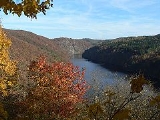
Štechovice Reservoir
Encyclopedia
Štěchovice Reservoir is a dam
on Vltava River built during 1937 - 1945 as the second stage of the Vltava Cascade. The dam is named after nearby village Štěchovice
.
The construction started before the war
and because of the need for electricity resources were allocated for the project in spite of general shortage. The power station was put in action in 1943. The reservoir had flooded Svatojánské Streams (Svatojánské proudy, http://www.svatojanske-proudy.cz/), the most dangerous but romantic part of Vltava.
The main role of the reservoir is to balance the water runoff from peak-load power station at Slapy Dam and to propel two Kaplan turbine
s with total installed power 2 x 11.25 MW (Štěchovice I). A lock
(20.1 m difference between water levels, length 118 m) handles ships with displacement
up to 1000 tons.
The reservoir is also used by the pumped-storage hydroelectric plant
Štěchovice II whose upper reservoir was created on the top of hill Homole. The plant was set in operations in 1947 and closed in 1991 due to obsolence. During 1992 - 1996 a new hydroelectric plant using the reservoirs was built. This plant uses reverse Francis turbine
with power 45 MW.
During 2002 floods
the turbines of both power plants were severely damaged. After overhaul the plants were put back in production in 2004 and 2005 respectively.
Dam
A dam is a barrier that impounds water or underground streams. Dams generally serve the primary purpose of retaining water, while other structures such as floodgates or levees are used to manage or prevent water flow into specific land regions. Hydropower and pumped-storage hydroelectricity are...
on Vltava River built during 1937 - 1945 as the second stage of the Vltava Cascade. The dam is named after nearby village Štěchovice
Štěchovice
Štěchovice is a market town and municipality in Prague-West District in the Central Bohemian Region of the Czech Republic. -Notes:*This article was initially translated from the Czech Wikipedia....
.
The construction started before the war
World War II
World War II, or the Second World War , was a global conflict lasting from 1939 to 1945, involving most of the world's nations—including all of the great powers—eventually forming two opposing military alliances: the Allies and the Axis...
and because of the need for electricity resources were allocated for the project in spite of general shortage. The power station was put in action in 1943. The reservoir had flooded Svatojánské Streams (Svatojánské proudy, http://www.svatojanske-proudy.cz/), the most dangerous but romantic part of Vltava.
The main role of the reservoir is to balance the water runoff from peak-load power station at Slapy Dam and to propel two Kaplan turbine
Kaplan turbine
The Kaplan turbine is a propeller-type water turbine which has adjustable blades. It was developed in 1913 by the Austrian professor Viktor Kaplan, who combined automatically adjusted propeller blades with automatically adjusted wicket gates to achieve efficiency over a wide range of flow and...
s with total installed power 2 x 11.25 MW (Štěchovice I). A lock
Lock (water transport)
A lock is a device for raising and lowering boats between stretches of water of different levels on river and canal waterways. The distinguishing feature of a lock is a fixed chamber in which the water level can be varied; whereas in a caisson lock, a boat lift, or on a canal inclined plane, it is...
(20.1 m difference between water levels, length 118 m) handles ships with displacement
Displacement (fluid)
In fluid mechanics, displacement occurs when an object is immersed in a fluid, pushing it out of the way and taking its place. The volume of the fluid displaced can then be measured, as in the illustration, and from this the volume of the immersed object can be deduced .An object that sinks...
up to 1000 tons.
The reservoir is also used by the pumped-storage hydroelectric plant
Pumped-storage hydroelectricity
Pumped-storage hydroelectricity is a type of hydroelectric power generation used by some power plants for load balancing. The method stores energy in the form of water, pumped from a lower elevation reservoir to a higher elevation. Low-cost off-peak electric power is used to run the pumps...
Štěchovice II whose upper reservoir was created on the top of hill Homole. The plant was set in operations in 1947 and closed in 1991 due to obsolence. During 1992 - 1996 a new hydroelectric plant using the reservoirs was built. This plant uses reverse Francis turbine
Francis turbine
The Francis turbine is a type of water turbine that was developed by James B. Francis in Lowell, Massachusetts. It is an inward-flow reaction turbine that combines radial and axial flow concepts....
with power 45 MW.
During 2002 floods
2002 European floods
In August 2002 a 100-year flood caused by over a week of continuous heavy rains ravaged Europe, killing dozens, dispossessing thousands, and causing damage of billions of euros in the Czech Republic, Austria, Germany, Slovakia, Poland, Hungary, Romania and Croatia....
the turbines of both power plants were severely damaged. After overhaul the plants were put back in production in 2004 and 2005 respectively.
Technical parameters of the reservoir
- height of the dam: 22.5 m
- length of the dam arch: 124 m
- held back water stretches 9.4 km
- reservoir area: 95.7 hectareHectareThe hectare is a metric unit of area defined as 10,000 square metres , and primarily used in the measurement of land. In 1795, when the metric system was introduced, the are was defined as being 100 square metres and the hectare was thus 100 ares or 1/100 km2...
s - water capacity: 11.2 million m³
- located on 84.4 km of the river
External links
- Overview on website of the operator, ČEZ (en, cz, de)
- Overview on website of Vltava River Authority (in Czech)
- Overview on website of Štěchovice village (in Czech)

